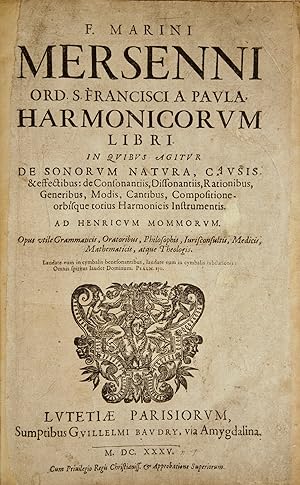MERSENNE, MARIN 1588 1648 (2 Ergebnisse)
Produktart
- Alle Produktarten
- Bücher (2)
- Magazine & Zeitschriften
- Comics
- Noten
- Kunst, Grafik & Poster
- Fotografien
- Karten
-
Manuskripte &
Papierantiquitäten
Zustand
Einband
- alle Einbände
- Hardcover
- Softcover
Weitere Eigenschaften
- Erstausgabe (1)
- Signiert
- Schutzumschlag
- Angebotsfoto
- Kein Print-on-Demand (1)
Gratisversand
Land des Verkäufers
Verkäuferbewertung
-
F. Marini Mersenni Ordinis Minim. Harmonicorum libri : ad illustr. virum Henricum Ludouicum Habertum Mommorum. (1636) [LeatherBound]
Erscheinungsdatum: 2022
Anbieter: S N Books World, Delhi, Indien
Buch Print-on-Demand
LeatherBound. Zustand: New. Leatherbound edition. Condition: New. Leather Binding on Spine and Corners with Golden leaf printing on spine. Bound in genuine leather with Satin ribbon page markers and Spine with raised gilt bands. A perfect gift for your loved ones. Reprinted from 1636 edition. NO changes have been made to the original text. This is NOT a retyped or an ocr'd reprint. Illustrations, Index, if any, are included in black and white. Each page is checked manually before printing. As this print on demand book is reprinted from a very old book, there could be some missing or flawed pages, but we always try to make the book as complete as possible. Fold-outs, if any, are not part of the book. If the original book was published in multiple volumes then this reprint is of only one volume, not the whole set. IF YOU WISH TO ORDER PARTICULAR VOLUME OR ALL THE VOLUMES YOU CAN CONTACT US. Resized as per current standards. Sewing binding for longer life, where the book block is actually sewn (smythe sewn/section sewn) with thread before binding which results in a more durable type of binding. Pages: 384 Language: Latin Pages: 384.
-
Harmonicorum Libri In Quibus Agitur De Sonorum Natura, Causis & effectibus: de Consonantiis, Dissonantiis, Rationibus, Generibus, Modis, Cantibus, Compositione orbisque totius Harmonicis Instrumentis
Verlag: Guillelmi Baudry, Paris, 1636
Anbieter: J & J LUBRANO MUSIC ANTIQUARIANS LLC, Syosset, NY, USA
Erstausgabe
Two parts bound in one. Folio. Early full dark brown panelled leather. With 21 fine engraved illustrations and more than 100 woodcut illustrations, mainly of musical instruments; numerous musical examples (some in lute tablature) and diagrams throughout; occasional woodcut head- and tailpieces, ornaments, and decorative initials. Typeset. Text in Latin. Part I 1f. (recto title, verso blank), 1f. (dedication), 4ff. (preface), 184 pp. Bound with: Part II. Harmonicorum Instrumentorum. 168 pp. Provenance From the collection of Sir Frederick A. Gore Ouseley (1825-1889), English church musician, composer, professor of Music at Oxford University, and collector of music and music theory books, with his signature in pencil to free front endpaper. Some early notation in pencil to Vol. I, most likely in Ouseley's hand. Binding slightly worn, rubbed, and bumped; restored and rebacked; endpapers slightly browned at margins. Slightly worn and browned; light to moderate dampstaining throughout; title slightly trimmed, soiled, and with small holes to blank areas, minor chips to margins, laid down to backing sheet; Part II with small hole to pp. 67/68, just touching illustration to p. 67 and affecting several letters of text to p. 68; lower outer corner of pp. 159/160 lacking, just touching lower outer corner of illustrative plate; occasional minor defects. Part I lacking signatures R and X4 (pp. 125-132 and 153-160), as is often the case in early issues; lacking pp. 163-166; pages 43-46 mispaginated. Part II lacking pp. 35-38; pages 148, 149, and 167 mispaginated. First Edition. Gregory-Bartlett, pp. 178-79 (with pp. 126-31 and 154-59 lacking in Vol. I). Cortot, p. 135. Hirsch I, 405. Wolffheim I, 836. Charbon (The Hague Gemeentemuseum) I, p. 95. Wood (Harvard) 988. RISM BVI, p. 572. Part I contains the earliest examples of music engraving in France. Part II is an important study on musical instruments of the late Renaissance and early Baroque. Mersenne was a "French mathematician, philosopher, music theorist and savant. He was one of the leading French thinkers of the 17th century, and his work is central to the academic and scientific movements of the second quarter of the century; an important part of it is devoted to the science, theory and practice of music. He was a transitional figure at a crucial confluence of Renaissance and Baroque ideas in France, summing up the accomplishments of the past and posing the difficult questions for the future inherent in the new attitudes of his own time." Albert Cohen in Grove Music Online "An examination of [the Harmonicorum] will at once show how much it was in advance of anything published up to that time, and it is the first in which the science of acoustics is applied practically to the study of Music. Perhaps to us in the present day the greatest interest is in the last four Books, treating of the various instruments known at that time, divided into stringed and wind instruments (the organ having a book to itself) and instruments of percussion, as bells and drums. These are illustrated profusely with woodcuts, as well as with engravings on copper, both printed in the text. It is worthy of notice that in treating of the organ, several schemes are given for dividing the octave into more than twelve semi-tones, so as to be able to use it in the keys impossible with unequal temperament." Matthew: The Literature of Music, p. 53. Mersenne also authored an early and influential work on music theory, Harmonie Universelle, published in Paris, 1636-37, addressing the relationship between music and mathematics and containing the earliest presentation of what have become known as "Mersenne's Laws" describing the harmonics of vibrating strings; he is thus often referred to as the "father of acoustics." A cornerstone of the literature.


![Bild des Verkäufers für F. Marini Mersenni Ordinis Minim. Harmonicorum libri : ad illustr. virum Henricum Ludouicum Habertum Mommorum. (1636) [LeatherBound] zum Verkauf von S N Books World](https://pictures.abebooks.com/inventory/md/md31650187112.jpg)
